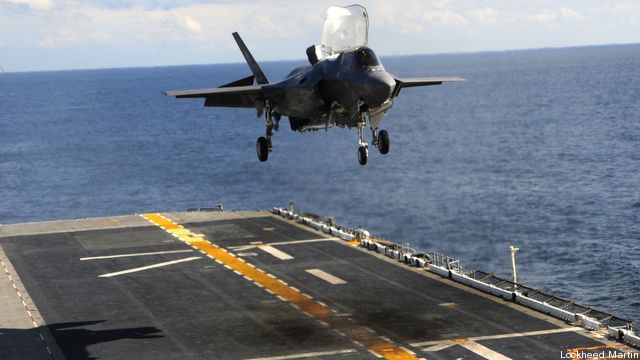F-35B Weight Margins Pretty Thin, OSD Testers Say
Posted on

UPDATED: Lockheed Martin Comments On F-35 Testing Finishing Year 15 % Ahead of Schedule
PENTAGON: If you want some idea of just how closely the Pentagon’s test and evaluation folks are watching Lockheed Martin’s F-35, just open the newly released annual report and thumb through the 12-plus pages of densely packed information about the aircraft.
The overall conclusion is that the most expensive conventional weapon in Pentagon history is doing, well, not too bad — but not nearly as well as it should.
In terms of flight tests, the Navy version is 32 percent ahead of the new schedule, while the Air Force version is 11 percent behind and the Marine version lags 9 percent behind the new schedule.
Perhaps the most interesting item in the report comes from the full-up system-level testing. In live fire testing — when they actually shoot stuff at the test item and analyze the results — testers found “the fuel tank inserting system is incapable of providing protection from threat-induced fuel tank explosions during some critical segments of combat missions when the aircraft is most likely to be hit.” This system, the report says, is being “redesigned” as a result of the testing. The new system will be tested again to see if it works.
One other important detail surfaces in the report, the weight of the Marines F-35B. While the issue of weight is not new for the STOVL aircraft, the report says the weight margin is not huge, roughly 235 pounds as of November. “managing weight growth with such tight margins for the balance of SDD will be a significant challenge, especially with over 70 percent of the scheduled F-35B flight sciences test flights remaining to be accomplished in the next 60 months.” The current F-35B weight allows for .36 percent weight growth per year, the report notes, compared to the F-18 E/F’s gain of .69 percent per year for the first 42 months after first flight.
Almost everything else in the test report has already been reported, including the deficient helmet, the cracked bulkheads and problems identified with the F-35B such as the overheating clutch.
After our story appeared, Lockheed spokesman Michael Rein contacted us to note that the program finished 15 percent ahead of its planned flight test schedule, among other things. His comment follows:
The DOT&E report recognizes the numerous accomplishments of the F-35 program in 2011 such as the outstanding results from F-35 STOVL ship trials, completion of F-35C structural testing and the fact flight sciences flight testing either matched or exceeded plan in 2011. It should be noted, however, the overall DOT&E report flight test numbers cited are only through November. Through Dec. 31, the flight test team completed 7,823 test points, an increase of 1,744 test points over the number published in the report. The 2011 official F-35 program flight test plan called for the accomplishment of 6,622 test points, therefore, the test team exceeded plan by 15 percent. Furthermore, the individual technical issues cited in the report are known issues that have engineering solutions either identified, in work or are currently in flight test.”
The OT&E folks traditionally post the report on their website. It isn’t up yet but click here to check.
Until then, here are a few of the more interesting tidbits we’ve had time to gather.
- A Special Operations version of the Oshkosh Defense-made M-ATV is “not operationally suitable,” which is pretty close to the nastiest thing an operational tester can say about a weapons system. The rear seat is “cramped and not comfortable,” causing a soldier to suffer cramps and fatigue after just 30 minutes. Also, the vehicle’s crew “had difficulty moving” from their seats to fighting positions. And half of the SOF operators complained of nausea when they sat in the back. worst of all for stealthy special operators, the M-ATV’s “large visual and loud aural signatures negate the SOF need for tactical surprise.” The testers didn’t have very nice things to say about the SOF M-ATV’s Common Remotely Operated Weapon Station II. Its sights “provide limited field of view for target acquisition.”
- The Joint Biological Point Detection System sounds as if it still has a long ways to go before it can be relied upon to do what it’s supposed to do. It has “limited capability to detect and identify tactically significant biological warfare agent attacks” well enough to “support decisions” to start medical treatment. Given the lasting concerns among senior Pentagon leaders about the threat by biological weapons, this is not reassuring.
- The Littoral Combat Ship is “not expected to be survivable in a hostile combat environment” the testers say. How can that be, you ask? “This assessment is based primarily on a review of LCS design requirements, which do not require the inclusion of the survivability features necessary to conduct sustained operations in its expected combat environment,” the report says. And the testers say, “the Navy has significantly delayed the release of of their Detail Design Survivability Assessment Reports for both” LCS designs so OT&E can’t tell us more. This isn’t new, but it bears repeating.
Subscribe to our newsletter
Promotions, new products and sales. Directly to your inbox.
